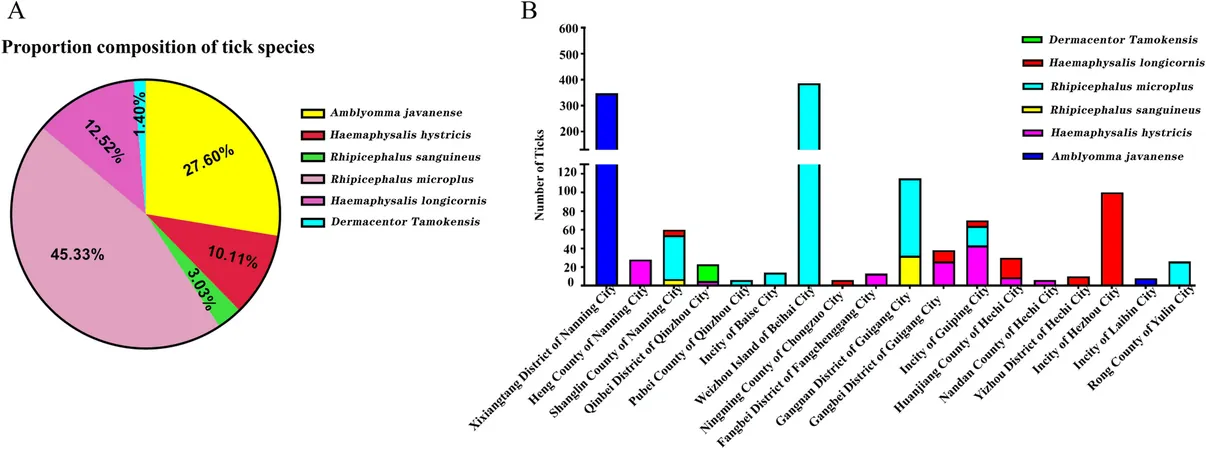
Unveiling the Jingmen Tick Virus: A Groundbreaking Study from Guangxi, China
2025-05-15
Author: Wei Ling
The Search for Ticks in Guangxi: A Comprehensive Study
In a groundbreaking study to identify ticks and their associated viruses, researchers meticulously collected samples from 17 counties across Guangxi, China, from January 2019 to March 2022. Utilizing random sampling methods, experts gathered ticks from wild and domesticated animals, ensuring each specimen was carefully preserved for accurate analysis.
Advanced Techniques for Tick Identification
To identify tick species, researchers relied on both morphological characteristics and molecular techniques. Morphological identification involved close examination under a microscope, relying on specific tick traits. However, challenges from incomplete DNA sequences in databases like NCBI necessitated molecular methods. For DNA extraction, they utilized the E.Z.N.A. Insect DNA Kit, employing PCR techniques to amplify sequences critical for accurate species identification.
Revealing the Virus: Extracting Nucleic Acids
A significant part of the study focused on detecting viral nucleic acids within tick samples. By systematically organizing sample pools based on various factors, the researchers utilized RNA extraction methods to prepare for next-gen sequencing. The samples were processed through high-throughput sequencing, generating vast amounts of data that provided unprecedented insights into viral diversity.
Discovering the Jingmen Tick Virus (JMTV)
Among the discoveries, the Jingmen Tick Virus (JMTV) emerged as a notable finding. With rigorous RT-PCR analysis confirming its presence in multiple tick pools, the research indicates a genetic divergence that suggests the existence of novel JMTV variants in Guangxi.
Implications of Tick-Borne Viruses on Public Health
Ticks are notorious vectors of various infectious diseases, and their ability to harbor numerous viruses poses a significant threat to public health. This study highlights the ongoing risk of zoonotic diseases as Guangxi's climate and ecology foster a fertile environment for ticks. The findings emphasize the need for enhanced surveillance programs to mitigate potential outbreaks.
Examining Genetic Recombination and Evolution
In a detailed analysis, researchers explored the phylogenetic relationships of JMTV. The study incorporated sequences from diverse sources, revealing a complex evolutionary history. Notably, the research unveiled potential recombination events in the viral genome, showcasing how genetic variations can emerge, adding layers to our understanding of viral resilience.
A Call to Action for Ongoing Research
Despite significant findings, researchers assert that further investigations are essential for a comprehensive understanding of JMTV and its impact on public health. As ecological and climatic changes continue to affect tick populations, ongoing surveillance and research remain critical to safeguarding human health against tick-borne diseases. This study not only contributes valuable data to scientific communities but also reinforces the urgency in addressing the risks these pathogens present.


 Brasil (PT)
Brasil (PT)
 Canada (EN)
Canada (EN)
 Chile (ES)
Chile (ES)
 Česko (CS)
Česko (CS)
 대한민국 (KO)
대한민국 (KO)
 España (ES)
España (ES)
 France (FR)
France (FR)
 Hong Kong (EN)
Hong Kong (EN)
 Italia (IT)
Italia (IT)
 日本 (JA)
日本 (JA)
 Magyarország (HU)
Magyarország (HU)
 Norge (NO)
Norge (NO)
 Polska (PL)
Polska (PL)
 Schweiz (DE)
Schweiz (DE)
 Singapore (EN)
Singapore (EN)
 Sverige (SV)
Sverige (SV)
 Suomi (FI)
Suomi (FI)
 Türkiye (TR)
Türkiye (TR)
 الإمارات العربية المتحدة (AR)
الإمارات العربية المتحدة (AR)